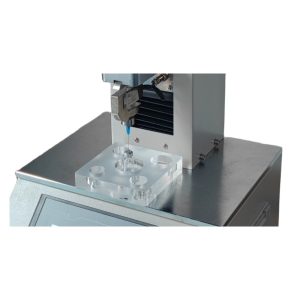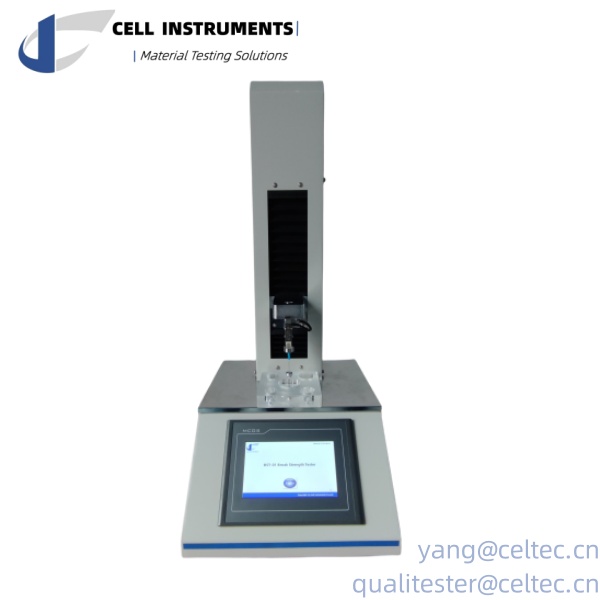ما هو اختبار الاختراق؟
ايزو 8871-5 هو معيار ضمن سلسلة ISO 8871، والذي يركز على اختبار قابلية الاختراق للمكونات المرنة للأجهزة القابلة للحقن والأدوية.
مقدمة عن ISO 8871-5 واختبار قابلية الاختراق
في عالم المستحضرات الصيدلانية، تعتبر سلامة وأداء السدادات المطاطية ذات أهمية قصوى. تُستخدم العديد من السدادات المطاطية للاستخدامات الصيدلانية جنبًا إلى جنب مع إبر الحقن. تُعَد القوة اللازمة لاختراق سدادة مطاطية أو ثقبها أحد المعايير المهمة في تقييم مدى ملاءمة السدادة للاستخدام المقصود منها. ايزو 8871-5 يسلط الضوء على هذه المتطلبات، وخاصة من خلال اختبار قابلية الاختراق.

تعريف قابلية الاختراق
في قلب إرشادات ISO 8871-5 يوجد معلمة المخترقية—يتم تعريفها باختصار على أنها القوة المطلوبة لاختراق سدادة مطاطية. ويدعم هذا التعريف نهج المعيار لضمان أن السدادات المستخدمة في التطبيقات الصيدلانية تلبي معايير الأداء الأساسية اللازمة للاستخدام المقصود منها.
أهمية قياس قوة الاختراق
إن قوة الاختراق ليست مجرد رقم؛ بل إنها مؤشر حاسم لملاءمة السدادات للاستخدامات الطبية والصيدلانية. فهي تخبر الشركات المصنعة والمستخدمين النهائيين عن توافق السدادات المرنة مع إبر الحقن، مما يضمن عدم إعاقة توصيل الأدوية بواسطة الحواجز المادية.
إجراءات الاختبار وفقًا للمعيار ISO 8871-5
قم بتثبيت إبرة الحقن والختم على تثبيت الجهاز على التوالي، ثم انقر فوق زر الاختبار، فيقوم الجهاز بدفع إبرة الحقن لاختراق الختم عموديًا، ويسجل أقصى قوة في نفس الوقت. (ملاحظة: يجب استبدال إبرة جديدة لكل تجربة)

جهاز اختبار ثقب الإبرة الطبية NPT-01
ال جهاز اختبار قابلية الاختراق NPT-01 تتيح شركة Cell Instruments عملية تقييم دقيقة من خلال إجراء اختبار مصمم بعناية، مع الالتزام الوثيق بإرشادات ISO 8871-5:
- إعداد العينة والمعدات: في البداية، يتم تجهيز الأغطية المرنة وفقًا لما تتطلبه المعايير، لضمان وصولها إلى الحالة المناسبة للخضوع للاختبار. يتم معايرة جهاز اختبار النفاذية وإعداده لاستقبال عينات الاختبار، مما يضمن أقصى قدر من الدقة.
- وضع الإغلاق: يتم بعد ذلك وضع الإغلاق بشكل آمن داخل منصة الاختبار الخاصة بجهاز اختبار NPT-01، ويتم وضعه بحيث يتماشى مع العنصر المخترق - عادةً إبرة أو مسبار محدد بواسطة معيار ISO.
- قياس قوة الاختراق: يقوم جهاز الاختبار NPT-01 بإجراء اختبار الاختراق عن طريق دفع الإبرة عبر السدادة بسرعة محددة. يتم تسجيل القوة المبذولة بدقة، مما يوفر بيانات قيمة حول قابلية اختراق المادة.
- تسجيل البيانات وتحليلها: عند الانتهاء من الاختبار، يقوم جهاز اختبار النفاذية بتسجيل قياسات القوة تلقائيًا. ومن ثم يمكن تحليل هذه النتائج لضمان التوافق مع متطلبات ISO 8871-5 ومعايير الجودة الداخلية.
- القدرة على التكرار والموثوقية: تم تصميم جهاز الاختبار NPT-01 ليكون قابلاً للتكرار، مما يسمح باختبار العديد من الإغلاقات في ظل ظروف متطابقة. تعد القدرة على التكرار هذه أمرًا بالغ الأهمية للحصول على بيانات إحصائية موثوقة، والتي بدورها تفيد عمليات مراقبة الجودة وشهادات الامتثال.
إن إدراج قابلية النفاذية، والتي تعرف بأنها القوة اللازمة لاختراق غطاء مطاطي، ضمن معايير ISO 8871-5، يؤكد على الدقة التي يجب أن تتمتع بها صناعات الأدوية والأجهزة الطبية في تقييم مكوناتها. ويضمن هذا التركيز على اختبار قابلية النفاذية أن المنتجات الناتجة لا تلبي معايير السلامة العالمية فحسب، بل تعمل أيضًا على تحسين رعاية المرضى من خلال ضمان توصيل الأدوية بسلاسة.
